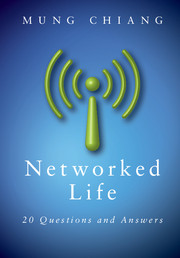Book contents
- Frontmatter
- Contents
- Preface
- Acknowledgements
- Roadmap
- 1 What makes CDMA work for my smartphone?
- 2 How does Google sell ad spaces?
- 3 How does Google rank webpages?
- 4 How does Netflix recommend movies?
- 5 When can I trust an average rating on Amazon?
- 6 Why does Wikipedia even work?
- 7 How do I viralize a YouTube video and tip a Groupon deal?
- 8 How do I influence people on Facebook and Twitter?
- 9 Can I really reach anyone in six steps?
- 10 Does the Internet have an Achilles' heel?
- 11 Why do AT&T and Verizon Wireless charge me $10 a GB?
- 12 How can I pay less for each GB?
- 13 How does traffic get through the Internet?
- 14 Why doesn't the Internet collapse under congestion?
- 15 How can Skype and Bit Torrent be free?
- 16 What's inside the cloud of iCloud?
- 17 IPTV and Netflix: How can the Internet support video?
- 18 Why is WiFi faster at home than at a hotspot?
- 19 Why am I getting only a few % of the advertised 4G speed?
- 20 Is it fair that my neighbor's iPad downloads faster?
- Index
- Notes
18 - Why is WiFi faster at home than at a hotspot?
Published online by Cambridge University Press: 05 November 2012
- Frontmatter
- Contents
- Preface
- Acknowledgements
- Roadmap
- 1 What makes CDMA work for my smartphone?
- 2 How does Google sell ad spaces?
- 3 How does Google rank webpages?
- 4 How does Netflix recommend movies?
- 5 When can I trust an average rating on Amazon?
- 6 Why does Wikipedia even work?
- 7 How do I viralize a YouTube video and tip a Groupon deal?
- 8 How do I influence people on Facebook and Twitter?
- 9 Can I really reach anyone in six steps?
- 10 Does the Internet have an Achilles' heel?
- 11 Why do AT&T and Verizon Wireless charge me $10 a GB?
- 12 How can I pay less for each GB?
- 13 How does traffic get through the Internet?
- 14 Why doesn't the Internet collapse under congestion?
- 15 How can Skype and Bit Torrent be free?
- 16 What's inside the cloud of iCloud?
- 17 IPTV and Netflix: How can the Internet support video?
- 18 Why is WiFi faster at home than at a hotspot?
- 19 Why am I getting only a few % of the advertised 4G speed?
- 20 Is it fair that my neighbor's iPad downloads faster?
- Index
- Notes
Summary
A crude answer is that interference management in WiFi does not scale well beyond several devices sharing one access point. When the crowd is big, the “tragedy of the commons” effect, due to mutual interference in the unlicensed band, is not efficiently mitigated by WiFi. To see why, we have to go into the details of WiFi's medium access control in the link layer of the layered protocol stack.
A Short Answer
How WiFi is different from cellular
Since their first major deployment in the late 1990s, WiFi hotspots have become an essential feature of our wireless lifestyle. There were already more than a billion WiFi devices around the world by 2010, and hundreds of millions are added each year. We use WiFi at home, in the office, and around public hotspots like those at airports, in coffee shops, or even around street corners.
We all know WiFi is often faster than 3G cellular, but you cannot move around too fast on WiFi service or be more than 100 m away from an Access Point (AP). We have seen many letters attached to 802.11, like 802.11a, b, g, and n, shown on the WiFi AP boxes you can buy from electronic stores, but maybe do not appreciate why we are cooking an alphabet soup. We have all used hotspot services at airports, restaurants, hotels, and perhaps our neighbor's WiFi (if it does not require a password), and yet have all been frustrated by the little lock symbol next to many WiFi network names that our smartphones can see but not use.
- Type
- Chapter
- Information
- Networked Life20 Questions and Answers, pp. 406 - 432Publisher: Cambridge University PressPrint publication year: 2012



